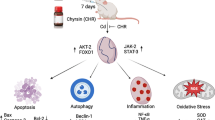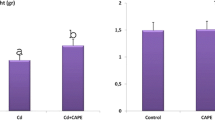Abstract
Ascorbic acid (AA), one of the best-known reactive oxygen species (ROS) scavengers, exhibits numerous functions such as antioxidant, anti-cancer, and anti-inflammatory effects. Increasing evidence demonstrates that oxidative stress plays an important role in testicular toxicity. In the present study, we investigated the protective effect of AA against cadmium (Cd)-induced blood-testis barrier (BTB) disruption. Sprague-Dawley (SD) rats were divided into four groups: the Cd-treated group received a single dose (s.c.) of 2 mg/kg BW cadmium chloride; the AA antagonism group received an injection of AA at a dose of 400 mg/kg BW (200 mg 24 h prior to Cd treatment and 200 mg 24 h following Cd treatment); and the control groups received an equal volume of saline or an equal dose of AA. As expected, ROS expression was upregulated in the Cd-treated rats, accompanied by an increase in malondialdehyde (MDA). Interestingly, AA suppressed Cd-induced oxidative stress by decreasing the levels of ROS and MDA and increasing the activity of superoxide dismutase (SOD) and catalase (CAT). In addition, AA also reduced BTB disruption by inhibiting TGF-β3 activation and p38 MAPK phosphorylation. Significant decreases in occludin and claudin-11 expression were observed in the Cd-treated rats, whereas AA administration attenuated this effect. Moreover, testicular histopathology and transmission electron microscopy further demonstrated the protective effects of AA against Cd-induced BTB damage. In conclusion, the results of the present study suggest that AA protects BTB destruction via the inhibition of oxidative stress and the TGF-β3/p38 MAPK signalling pathway in the testis of Cd-exposed rats.






Similar content being viewed by others
References
Akinloye O, Arowojolu AO, Shittu OB, Anetor JI (2006) Cadmium toxicity: a possible cause of male infertility in Nigeria. Reprod Biol 6:17–30
Amara S, Abdelmelek H, Garrel C, Guiraud P, Douki T, Ravanat JL, Favier A, Sakly M, Ben Rhouma K (2006) Influence of static magnetic field on cadmium toxicity: study of oxidative stress and DNA damage in rat tissues. J Trace Elem Med Biol 20:263–269
Angenard G, Muczynski V, Coffigny H, Pairault C, Duquenne C, Frydman R, Habert R, Rouiller-Fabre V, Livera G (2010) Cadmium increases human fetal germ cell apoptosis. Environ Health Perspect 118:331–337
Anonymous (1993) Meeting of the IARC working group on beryllium, cadmium, mercury and exposures in the glass manufacturing industry. Scand J Work Environ Health 19:360–363
Bonaventura J, Schroeder WA, Fang S (1972) Human erythrocyte catalase: an improved method of isolation and a reevaluation of reported properties. Arch Biochem Biophys 150:606–617
Cheng CY, Mruk DD (2012) The blood-testis barrier and its implications for male contraception. Pharmacol Rev 64:16–64
Cheng CY, Wong EW, Lie PP, Li MW, Su L, Siu ER, Yan HH, Mannu J, Mathur PP, Bonanomi M, Silvestrini B, Mruk DD (2011) Environmental toxicants and male reproductive function. Spermatogenesis 1:2–13
Chung NP, Cheng CY (2001) Is cadmium chloride-induced inter-Sertoli tight junction permeability barrier disruption a suitable in vitro model to study the events of junction disassembly during spermatogenesis in the rat testis? Endocrinology 142:1878–1888
Consoli C, Gatta L, Iellamo F, Molinari F, Rosano GM, Marlier LN (2013) Severity of left ventricular dysfunction in heart failure patients affects the degree of serum-induced cardiomyocyte apoptosis. Importance of inflammatory response and metabolism. Int J Cardiol 167:2859–2866
Duan P, Hu CH, Butler HJ, Quan C, Chen W, Huang WT, Tang S, Zhou W, Yuan M, Shi YQ, Martin FL, Yang KD (2016) Effects of 4-nonylphenol on spermatogenesis and induction of testicular apoptosis through oxidative stress-related pathways. Reprod Toxicol 62:27–38
Fraga CG, Motchnik PA, Shigenaga MK, Helbock HJ, Jacob RA, Ames BN (1991) Ascorbic acid protects against endogenous oxidative DNA damage in human sperm. Proc Natl Acad Sci U S A 88:11003–11006
Ha YM, Park MK, Kim HJ, Seo HG, Lee JH, Chang KC (2009) High concentrations of ascorbic acid induces apoptosis of human gastric cancer cell by p38-MAP kinase-dependent up-regulation of transferrin receptor. Cancer Lett 277:48–54
Hsu PC, Liu MY, Hsu CC, Chen LY, Guo YL (1998) Effects of vitamin E and/or C on reactive oxygen species-related lead toxicity in the rat sperm. Toxicology 128:169–179
Jarup L, Akesson A (2009) Current status of cadmium as an environmental health problem. Toxicol Appl Pharmacol 238:201–208
John LJ, Fromm M, Schulzke JD (2011) Epithelial barriers in intestinal inflammation. Antioxid Redox Signal 15:1255–1270
Kakkar P, Das B, Viswanathan PN (1984) A modified spectrophotometric assay of superoxide dismutase. Indian J Biochem Biophys 21:130–132
Kamiya Y, Ohta Y, Imai Y, Arisawa T, Nakano H (2005) A critical role of gastric mucosal ascorbic acid in the progression of acute gastric mucosal lesions induced by compound 48/80 in rats. World J Gastroenterol 11:1324–1332
Khan R, Khan AQ, Qamar W, Lateef A, Tahir M, Rehman MU, Ali F, Sultana S (2012) Chrysin protects against cisplatin-induced colon. Toxicity via amelioration of oxidative stress and apoptosis: probable role of p38MAPK and p53. Toxicol Appl Pharmacol 258:315–329
Li Y, Wu J, Zhou W, Gao E (2016) Association between environmental exposure to cadmium and human semen quality. Int J Environ Health Res 26:175–186
Lin JL, Huang YH, Shen YC, Huang HC, Liu PH (2010) Ascorbic acid prevents blood-brain barrier disruption and sensory deficit caused by sustained compression of primary somatosensory cortex. J Cereb Blood Flow Metab 30:1121–1136
Liu J, Qu W, Kadiiska MB (2009) Role of oxidative stress in cadmium toxicity and carcinogenesis. Toxicol Appl Pharmacol 238:209–214
Lui WY, Lee WM, Cheng CY (2001) Transforming growth factor-beta3 perturbs the inter-Sertoli tight junction permeability barrier in vitro possibly mediated via its effects on occludin, zonula occludens-1, and claudin-11. Endocrinology 142:1865–1877
Lui WY, Lee WM, Cheng CY (2003a) TGF-betas: their role in testicular function and Sertoli cell tight junction dynamics. Int J Androl 26:147–160
Lui WY, Wong CH, Mruk DD, Cheng CY (2003b) TGF-beta3 regulates the blood-testis barrier dynamics via the p38 mitogen activated protein (MAP) kinase pathway: an in vivo study. Endocrinology 144:1139–1142
Ohkawa H, Ohishi N, Yagi K (1979) Assay for lipid peroxides in animal tissues by thiobarbituric acid reaction. Anal Biochem 95:351–358
Ozawa N, Goda N, Makino N, Yamaguchi T, Yoshimura Y, Suematsu M (2002) Leydig cell-derived heme oxygenase-1 regulates apoptosis of premeiotic germ cells in response to stress. J Clin Invest 109:457–467
Padh H (1990) Cellular functions of ascorbic acid. Biochem Cell Biol 68:1166–1173
Peus D, Vasa RA, Beyerle A, Meves A, Krautmacher C, Pittelkow MR (1999) UVB activates ERK1/2 and p38 signaling pathways via reactive oxygen species in cultured keratinocytes. J Invest Dermatol 112:751–756
Ruan Y, Dong C, Patel J, Duan C, Wang X, Wu X, Cao Y, Pu L, Lu D, Shen T, Li J (2015) SIRT1 suppresses doxorubicin-induced cardiotoxicity by regulating the oxidative stress and p38MAPK pathways. Cell Physiol Biochem 35:1116–1124
Sen Gupta R, Kim J, Gomes C, Oh S, Park J, Im WB, Seong JY, Ahn RS, Kwon HB, Soh J (2004a) Effect of ascorbic acid supplementation on testicular steroidogenesis and germ cell death in cadmium-treated male rats. Mol Cell Endocrinol 221:57–66
Sen Gupta R, Sen Gupta E, Dhakal BK, Thakur AR, Ahnn J (2004b) Vitamin C and vitamin E protect the rat testes from cadmium-induced reactive oxygen species. Mol Cells 17:132–139
Siu ER, Mruk DD, Porto CS, Cheng CY (2009) Cadmium-induced testicular injury. Toxicol Appl Pharmacol 238:240–249
Su L, Mruk DD, Lee WM, Cheng CY (2010) Differential effects of testosterone and TGF-beta3 on endocytic vesicle-mediated protein trafficking events at the blood-testis barrier. Exp Cell Res 316:2945–2960
Suzuki T, Hara H (2011) Role of flavonoids in intestinal tight junction regulation. J Nutr Biochem 22:401–408
Turner JR (2009) Intestinal mucosal barrier function in health and disease. Nat Rev Immunol 9:799–809
Usatyuk PV, Vepa S, Watkins T, He D, Parinandi NL, Natarajan V (2003) Redox regulation of reactive oxygen species-induced p38 MAP kinase activation and barrier dysfunction in lung microvascular endothelial cells. Antioxid Redox Signal 5:723–730
Walsh SV, Hopkins AM, Nusrat A (2000) Modulation of tight junction structure and function by cytokines. Adv Drug Deliv Rev 41:303–313
Watjen W, Beyersmann D (2004) Cadmium-induced apoptosis in C6 glioma cells: influence of oxidative stress. Biometals 17:65–78
Wong EW, Cheng CY (2009) Polarity proteins and cell-cell interactions in the testis. Int Rev Cell Mol Biol 278:309–353
Wong CH, Mruk DD, Lui WY, Cheng CY (2004) Regulation of blood-testis barrier dynamics: an in vivo study. J Cell Sci 117:783–798
Wong EW, Mruk DD, Lee WM, Cheng CY (2010): Regulation of blood-testis barrier dynamics by TGF-beta3 is a Cdc42-dependent protein trafficking event. Proc Natl Acad Sci U S A 107:11399–404
Worthington JJ, Klementowicz JE, Travis MA (2011) TGFbeta: a sleeping giant awoken by integrins. Trends Biochem Sci 36:47–54
Xia W, Mruk DD, Lee WM, Cheng CY (2006) Differential interactions between transforming growth factor-beta3/TbetaR1, TAB1, and CD2AP disrupt blood-testis barrier and Sertoli-germ cell adhesion. J Biol Chem 281:16799–16813
Xia W, Wong EW, Mruk DD, Cheng CY (2009) TGF-beta3 and TNFalpha perturb blood-testis barrier (BTB) dynamics by accelerating the clathrin-mediated endocytosis of integral membrane proteins: a new concept of BTB regulation during spermatogenesis. Dev Biol 327:48–61
Yan HH, Mruk DD, Lee WM, Cheng CY (2008) Blood-testis barrier dynamics are regulated by testosterone and cytokines via their differential effects on the kinetics of protein endocytosis and recycling in Sertoli cells. FASEB J 22:1945–1959
Zeng LH, Wu J, Carey D, Wu TW (1991) Trolox and ascorbate: are they synergistic in protecting liver cells in vitro and in vivo? Biochem Cell Biol 69:198–201
Author information
Authors and Affiliations
Corresponding author
Ethics declarations
Conflict of interest
The authors declare that they have no conflicts of interest.
Additional information
Responsible editor: Philippe Garrigues
Rights and permissions
About this article
Cite this article
Chen, N., Su, P., Wang, M. et al. Ascorbic acid inhibits cadmium-induced disruption of the blood-testis barrier by regulating oxidative stress-mediated p38 MAPK pathways. Environ Sci Pollut Res 25, 21713–21720 (2018). https://doi.org/10.1007/s11356-018-2138-4
Received:
Accepted:
Published:
Issue Date:
DOI: https://doi.org/10.1007/s11356-018-2138-4




